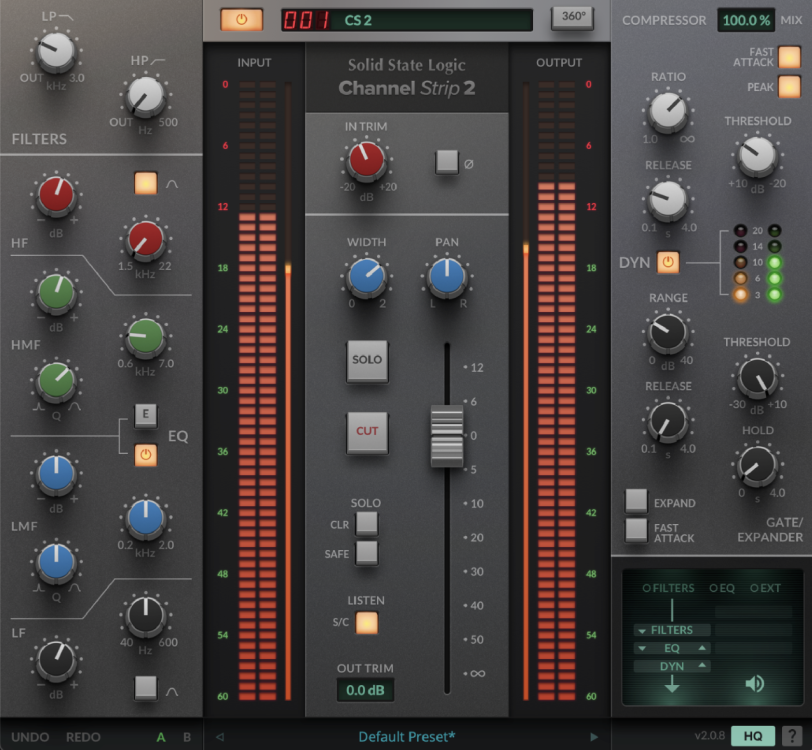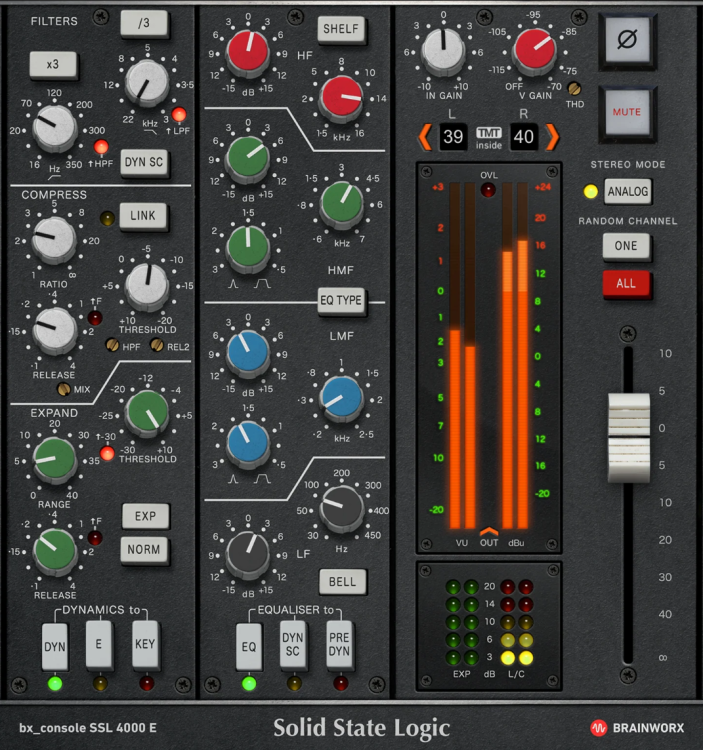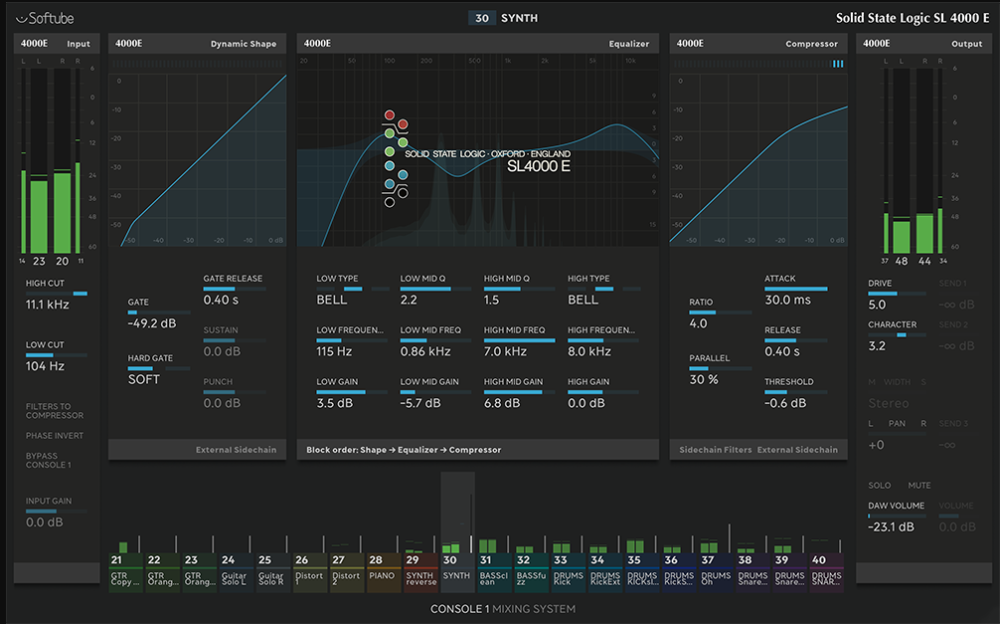
Carl Ewing
Members-
Posts
532 -
Joined
-
Last visited
Reputation
711 ExcellentRecent Profile Visitors
The recent visitors block is disabled and is not being shown to other users.
-
Weird - these are my least favorite, and i think worst sounding flagships on the market. I'm actually not sure how Arturia makes the filters in Pigments sound so terrible, considering they make some of my favorite software filters (eg. Filter MS-20)...although still waaay behind Cymatic, Audiority, U-He, Spectrasonics and now Synapse with The Legend HZ. I would argue Pigments is the worst sounding soft synth around. The only time I ever reach for Pigments is when I actually need something fairly cold and lifeless. Not even exagerating - that's my go to for really digital sounding, lifeless synths - which is sometimes needed. I honestly don't get the praise, when there are far better alternatives around in every other respect. Perhaps people like the presets, which would also be strange considering the best sound / patch designers in the world work on Omnisphere and U-He synths (Howard Scarr, Kevin Schroeder, Eric Persing, The Unfinished, etc.). I was just thinking that Drive score was made using Omnisphere, and the Dark Knight Trilogy (gorgeous synth parts) were made using Zebra2...and yet in 2025, Pigments still can't even compete with the synths in these iconic scores, which were like 15+ years ago now.
-
Focusrite Midnight And Scarlett Plugin Suites Are Now FREE (Legacy)
Carl Ewing replied to Patrick Wichrowski's topic in Deals
Installing VST2-only plugins in 2025 - that will never be updated again - is not smart. People don't think of legacy support when hoarding this stuff. Steinberg stopped issuing VST2 licenses in 2018, and removed VST2 SDK from public availability in 2022. Cubase / Nuendo are the first DAWs to stop displaying VST2 by default (you have to manually activate their paths), but it won't be the last. Case in point. People underestimate how big a pain the ***** (and potentially how expensive) this kind of thing is in the long run. EDIT: On a related note - I am amazed how good a job U-He did ensuring projects that used old VST2 versions of their plugins (even going back like 15 years) still load the VST3 versions...which is all they support anymore. Was opening a bunch of very old projects this weekend, and they are obviously using IPluginCompatibility in the VST3 SDK to ensure when the DAW sees "Zebra2(x64).dll" that it automatically flips to "Zebra2.vst3". It understands that the VST ID, file name and file format have changed, and loads in the newest version with full backward capability. Very few developers know how to do this, nor care enough to try. -
Have an iPad / tablet? Old phones? Use Decibel. Add it as an insert on the master bus - projects to mobile device (I use an old 10" iPad). No more opening / closing metering. Non-stop dedicated metering display (RMS, LUFS, phase, spectragraph, etc.) https://process.audio/en/products/decibel Acts exactly like TC Electronic Clarity M hardware, with way more customizability. One of the best purchases I ever made.
-
Now a deal.. Native Instruments - Absynth 6 ($199.00 or ($99.00 to Update))
Carl Ewing replied to MusicMan's topic in Deals
NI often offers a Happy New Year voucher as well. There was one this year on Jan 1, although it required $200 basket I think. It's usually either a percentage discount or occasionally a $25 / $35 dollar voucher. -
Sooo.... What did everyone get? (Not A Deal, Full Kontakt Not Required)
Carl Ewing replied to husker's topic in Deals
This can be done well though. For example, I much prefer this cleaner / flatter UI style for SSL channel strip: Versus the more rough UI "vintage" style: Although - ideally - I prefer this - the SL 4000 E console channel strip for Console 1. At least...I like the UI style. I *really* don't like the horizontal scrolling of parameters. They should have kept it rotary. -
8.8? Running out of numbers. Kontakt 9 soooooooon. The milkening will continue.
-
Sooo.... What did everyone get? (Not A Deal, Full Kontakt Not Required)
Carl Ewing replied to husker's topic in Deals
Interesting - I strongly prefer SpecCraft to handle these tasks. Although Pro Q 4 can sometimes handle special cases too. Compared to Track Spacer or Fuser, SpecCraft has way more helpful feature set for these unmasking tasks - like mid/side, multi-band eq for the sidechain, stereo channel unlinking, etc. And it's a vastly superior resonance suppressor than Reso. I'd put it way above even Soothe2. And it's on sale for $69 right now. That thing would replace a bunch of different plugins when it comes to any kind of masking, sidechaining, resonance suppression. In my opinion of course. -
Sooo.... What did everyone get? (Not A Deal, Full Kontakt Not Required)
Carl Ewing replied to husker's topic in Deals
Really minimal purchases this year, and I have quite a large budget. I think most stuff is absurdly overpriced, even on sale. 15-20 years ago I'd spend $300 on a plugin (UAD), or $1500 on an orchestral library (LASS, Symphobia, EWQL orchestra, etc.). There was minimal competition, and you had to pay a lot for the best. Now I will hesitate on a plugin over $50, or a library over $250. Some of the prices I saw this year are just comical considering the level of competition. I get an email offering a Composer Cloud renewal for $100 - so the entire East West catalog for a year for $100, and Spitfire is still trying to charge $300-$500 for solitary (and old) libraries. So I can have 5 years of Composer Cloud for the cost of Albion ONE - which I own, but is hugely dated sounding now. Oeksound is still trying to charge $200 for Soothe2. Kalifornia Dynamic charging $200 for Alkane. Fab Filter still trying to charge $170 for Pro-G gate. Tone Projects charging $250 for Michelangelo EQ. Like what? I'm grandfathered into the highest PA subscription for $150 a year, get 200 plugins to use, and get to pick 10 of them to own in that year. Many of which directly compete with these "premium" plugins. Who on earth would spend $200 on Soothe2 in 2025 considering the superior, and cheaper competition? Who would spend $300 on Pro Q 4 / Pro C 2, when for less you could get a PA subscription and get to 10 to own, like, Kirchhoff EQ & Cenozoix compressor, which are arguably superior to FF, and have another 200 plugins to demo for a year. The only company I occasionally bite the bullet on is Orchestral Tools, because the quality is often unmatched. But this year, I just decided to not buy almost anything. Had about $4000 in products in my "want" list. Spent $500, mostly on updating a few things. I suspect 2026 is going to a bloodbath in this industry leading to some sales. Not that I want to benefit of other people misery! Blah. -
Ah yes - totally agree. Surprisingly, the only one that is always visibly running on my system is UA Connect. I guess iLok, but I only use the USB key (easier swapping between multiple systems). And there's probably background services running for Waves, NI, etc. that I don't notice. Luckily, there are very few companies trying to force always-on processes / tray icons. However - I've never tried to run offline - curious how much stuff would break.
-
These are (I think) identical apps. uJam are co-founders of Crow Hill along with Henson. Perhaps in the future they'll just have one app for both.
-
I used to 100% agree with you. However, I do appreciate these installers more lately, since I have a large collections from many of these companies (Arturia, NI, iZotope, Plugin Alliance, Waves, IK, Spitfire, uJam, East West, Orchestral Tools, etc.) and it massively helps simplify installation, updates, removals, inventory, etc. I actually do not miss the days of downloading a gazillion .exe files, having to manually set installation paths (plugin & data) for 100s of programs, manually keep track of updates, having to go a website to check on what I do / don't own, etc., and having to manually authorize everything. I recently did an OS reinstall on one system - it is sooooo much easier than it used to be. Other than a few outlier companies (eg. Fab Filter), I just install a company's app, set up install preferences, and let it install everything while I move on the next install. For many of them it also automatically syncs external drive data across a dozen + products within a couple clicks, allows me to only install VST3 (or whatever format I need), and once everything is installed I will only need to open the app again to check on updates, or install a new product. I'm actually now annoyed with companies that want me to download a new file for every plugin, and don't give me a plugin manager to just do it all inside one app. I forget which company it is (D16 maybe?), where I had to download like 11 different .exes, manually set VST2 32/64 11 times, auto installed CLAP, AAX, VST2, VST3, in multiple bit formats, and then had to download 11 different authorization files and then manually authorize each one by opening them in the DAW. Remember.....this is how it used to be for almost everything! New OS installs would take many many days because of this. And you'd constantly be dealing with a dozen different authorization formats - some requiring downloadable authorization files, some had challenge / response, copy / pasting serial numbers, logging in for every install, having to open every single plugin in the DAW to authorize manually, and on and on. Then, a couple months later you'd realizing most of your plugins were out of data, and you'd have to manually download everything again to update one by one. F that. Those days are not missed. I actually can't believe Spectrasonics is still on challenge / response authorization. I fully appreciate that I can now download, say, Plugin Alliance's manager, select ALL, select VST3, and it installs and authorizes the entire subscription catalog in a couple minutes running in the background. Same goes for Native Instruments - holy hell, is it way better to do installs and library relinking in Native Access than it was before. These apps save literally hours and hours or time. Anyway - that's my defense. I do get annoyed when I have to install a whole app when I only own 1 product from a company. That's a PITA. I will agree there. But not when it's dozens or hundreds of plugins from a company to manage. Once a month I'll open Native Access or Ujam app or whatever, and just hit "update all" and it's done. This is so much better than the past.
-
EastWest Ancient Kingdom - $61.41 with code at JRRShop (RRP $299)
Carl Ewing replied to MusicMan's topic in Deals
It's at absurdity levels. Jamming 1,040 microphone positions - with full 27:2 surround atmos support (extra sub in the *****?) ) - into a flute library is just a giving the middle finger to customers at this point lol. Their orchestra is bad enough - I ain't occupying 1TB for an orchestra that sounds like the underscore for Law & Order SVU. At least Orchestral Tools justifies their drive footprint and gives option to self-select mic positions. -
Oh - I didn't even notice they added this! Thanks for the heads up. Grabbing that immediately. That's one of the better mixing / mastering Youtube channels imo. I think his Expendables-cast-member appearance is already the clickbait, so he's usually just down to business, and uses some great music to explain concepts, review products. Although he reviews a lot of expensive hardware - but will also compare to the plugin version if it's available.
-
Amazingly, you can use both. It's not an all or nothing thing. There are certain EQs I like the sound of - and i go to those EQs for specific curves in a simple interface. I don't want to be pulling Pro Q or Kirchoff for doing simple air band or low end control. What usually happens with these plugins is I spend 20 minutes ****ing around with dynamics or complex curves, when I already know a 1081 or Maag4 or Manley can get me amazing results in 10 seconds. Some would say we like these emulations because we've been listening to music for decades that uses these specific EQ curves & saturation in mixing / mastering. That's probably true. But they wouldn't be used if they sounded terrible. Ha. An unusual and excellent take on why unlimited band parametric EQs shouldn't be your first choice. Timestamp 1:17. (helps that I really like this guys' mixes, and I've heard this philosophy from other mixers I really like): I tend to agree here. Also - it's likely most of your favorite sounding albums were made using fixed band / fixed Q EQs & channel strips. With more complex EQs being used sparingly for problematic areas. I actually started overly relying on Pro-Q the last few years, and it's led to so many overcomplicated mixes, with infinitely more complex curves than I actually needed, and when I started switching back to channel strips - or fixed band EQs like the 1081, things got much easier, and imo started sounding better and more glued together. Although - I would add - don't give up on EQs like the Curve Bender, if you bought it and mess around with for a week. I think a lot of people buy an analog EQ, then buy another one, then another one, and then you have 50 channel strip EQs and stand alone EQs, and have no idea what any of them actually sound like. These are incredible EQs that could easily be used to master (or mix in some cases) entire albums. But it takes a LONG time to learn what they sound like and what they're good for. (EDIT: Was going to recommend - if you're starting out, and want a blend of a mastering EQ like the Curve Bender, with switchable freq / q) but also with a spectrum analyzer and visual curve like Pro Q, check a demo of the Lindell EQ825. It sounds a lot different than the Chandler, but having the EQ graph / spectrum analyzer (which is optional in the U) in an analog EQ is a fantastic learning tool...and it shows you how versatile / complex you can get even with limited bands.)
-
🔥🔥🔥 Cinesamples Musio 1 Perpetual License $119.60 (RRP $399) 🔥🔥🔥
Carl Ewing replied to MusicMan's topic in Deals
This does not sound great, sorry. Those strings, choir, brass, percussion, piano sound dreadful. Brass is great, because it's ported from Cinebrass - one of the greatest brass libraries ever made. That guys track relies heavily on the brass...unsurprisingly. Let me clarify again - if you need something - anything - and have limited budget Musio is probably great. Cheap, perpetual, very large mid-tier libraries that cover tons of categories. But there is MUCH better stuff around, including free libraries that are excellent (Project Sam, Spitfire, etc.). In capable hands of course. 🤣And something like Composer Cloud is like $10 a month and blows Musio away. I know people here can afford this, because their post history is filled with buying cheap crap hand over fist, month after month after month. Ha.






